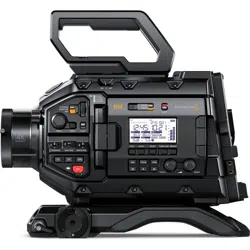Loading ...
Loading ...
Loading ...

Choosing Frame Rates
Your camera is able to shoot video using many different frame rates and you may be wondering
which is the best one to use. Your camera’s sensor frame rate can also have a big impact on the
‘look’ of footage. Generally, when selecting a sensor frame rate, there are some common items
to consider. For many years, there have been presentation standards for film and television.
These have set frame rates that differ between countries, but all share the same purpose;
todisplay an efficient number of frames every second that portrays pleasing and
convincing motion.
Cinema, for example, uses a standard 24 frames per second and while there have been recent
experiments with faster frame rates, 24 frames per second remains widely accepted for
international audiences. Television frame rates have generally conformed to technical
broadcast standards for each country. For example, if you were making television content you
would typically record using 29.97 frames per second for North American distribution, and
25frames per second for Europe.
However, as technology has improved, today we have more choices and broadcast standards
are changing. It is now common for sporting events to be recorded and broadcasted at higher
frame rates. For example, some sporting events are recorded and broadcasted at up to 59.94
frames per second in North America, and 50 frames per second in Europe. This provides
smoother motion on fast action and appears more lifelike. Alternatively, streaming and online
broadcasters normally use frame rates similar to television, however there is more freedom to
experiment due to user selectable viewing formats, and being limited only to what the
audience’s screens are capable of displaying.
Generally, when choosing a frame rate for a project, let your delivery format guide your choice.
Your camera’s project frame rate should be set to this, and your sensor frame should be set to
match. This means your clips will play back at the same speed the event happened in real life.
If you are looking to create an interesting effect, for example slow motion, then you can set the
sensor frame rate to a higher setting. The higher the sensor frame rate compared to the project
frame rate, the slower the playback speed.
For more information on using off speed sensor frame rates to achieve creative effects, refer
to the ‘touchscreen controls’ section.
Shooting at High Frame Rates
When shooting at high frame rates, your camera captures an increased number of frames per
second when compared with the traditional sync speed frame rates of 24, 25 and 30 frames
per second. This means that the image sensor has less time to collect light for each frame it
captures and the resulting image from your camera will be darker.
So for example, if you switch from 25 to 50 frames per second, the amount of light reaching
the sensor will be halved. To maintain your exposure you need to compensate for this change
by opening up your lens an extra stop, by opening up your shutter angle from 180º to 360º or
by adding some extra lighting to the scene that you are shooting.
When shooting at 60 frames per second you have 2.5 times less light than 24 frames per
second so you may need to adjust multiple things such as lens aperture, shutter angle and
lighting to achieve the same level of exposure.
Another thing to be mindful of when shooting at higher frame rates, is the fact that electronic
light sources can add flicker to your recorded image. Artificial light sources such as tungsten,
fluorescent and LED may introduce some flicker to your images. You may not see these flicker
issues when previewing the scene on your LCD and SDI feed or while recording, so it’s
important to perform a test shoot with the lights you plan to use and to play the clip back to
check for flicker.
33Recording
Loading ...
Loading ...
Loading ...
